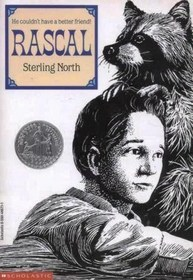By Andrew Porter: According to a Nature program on PBS last evening — Raccoon Nation — when Sterling North’s novel Rascal, about a boy and his raccoon, with cover and interior illustrations by SF artist John Schoenherr, was published, it set off a chain of events which were to lead to ecological disaster in Japan. Made into an anime, thousands of Japanese children implored their parents to buy them a pet raccoon. Pet importers brought them into Japan, where they are not native. When they became mature they were destructive and unmanageable, and they ended up being released into forests across the country.
Raccoons have bred into an enormous population, unchecked by natural predators. Their predilection for roosting in trees has meant they have moved en masse into Japanese temples, where, according to the program, they’ve done more damage in the last few decades than in the previous 700 years, tearing up roofs, destroying timbers and turning centuries-old wooden floors into urine and feces-soaked nests.
From Wikipedia:
North published his most famous work, Rascal, in 1963. The book is a remembrance of a year in his childhood when he raised a baby raccoon which he named Rascal. It received a Newbery Honor in 1964, a Sequoyah Book Award in 1966, and a Young Reader’s Choice Award in 1966. It was made into the Disney movie of the same name in 1969. Additionally, it was made into a 52-episode Japanese anime entitled Araiguma Rasukaru.?Araiguma Rascal means Racoon Rascal. The success of the anime was responsible for the unfortunate introduction of the North American Raccoon into Japan.
The success of Rascal was good news for Schoenherr. The success of the book launched a new career illustrating books, and within several years he ceased to illustrate science fiction.
Discover more from File 770
Subscribe to get the latest posts sent to your email.


Andrew may be able to confirm, I think I’ve seen that documentary before on raccoons. I think it’s a Canadian documentary on raccoons in Toronto, and how they are not just surviving, but thriving, mostly because we are messy and they are extremely intelligent, and getting smarter in the big city.
I thought there was a sort of indigenous Japanese racoon — They’re the stars in a lesser known animated feature by Ghibli studios, and directed bg Isao Takahata. Of course, North American racoons don’t have the power to change shape and appearance, or to stretch their testicles far enough to conceal a small car…
Yep: the tanuki, which is actually more closely related to dogs than raccoons.
Errr, that’s not the headline I wrote. My article focused on the fact that Schoenherr’s artwork contributed to the craze for raccoons in Japan that ended in ecological disaster.
By changing the headline, you changed the article’s emphasis.
Public Announcement: Yes, I’m to blame for the headline.
@Andrew: Your headline “John Schoenherr, Sterling North Set in Motion Japanese Ecological Disaster” was too simply long for my format. At least the headline I used is derived from your closing lines and relates to the equally compelling story about Schoenherr’s departure from sf, no small loss to us.
Was the book a hit in Japan, or was the anime only responsible?
Are Schoenherr’s illustrations in the Japanese edition?
Does the style of the anime resemble Schoenherr’s?
Hmm, this link gets me lots of images of the show
.
Not particularly Schoenherr-like!
Here’s the cover of the Japanese edition of Rascal.
I have a page about the Araiguma Rascal cartoon, too, with lots of images.